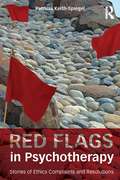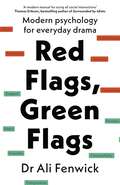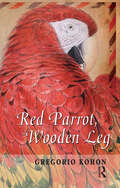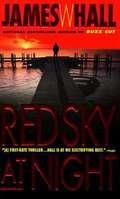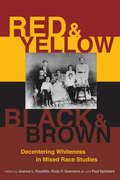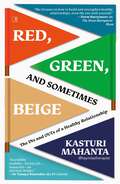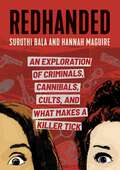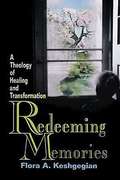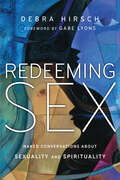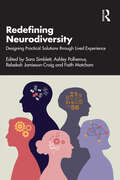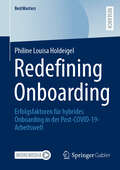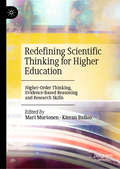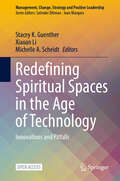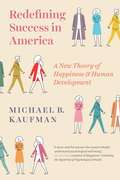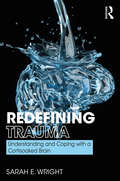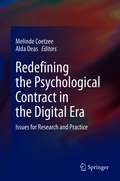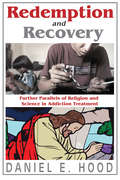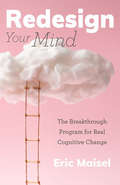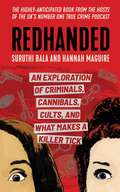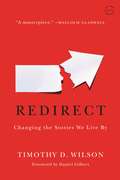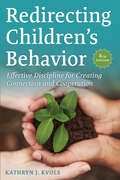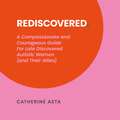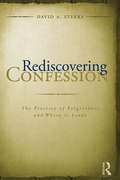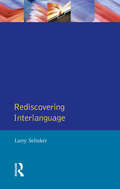- Table View
- List View
Recursion: Complexity in Cognition
by Tom Roeper Margaret SpeasThis volume focuses on recursion and reveals a host of new theoretical arguments, philosophical perspectives, formal representations and empirical evidence from parsing, acquisition and computer models, highlighting its central role in modern science Noam Chomsky, whose work introduced recursion to linguistics and cognitive science and other leading researchers in the fields of philosophy, semantics, computer science and psycholinguistics in showing the profound reach of this concept into modern science. Recursion has been at the heart of generative grammar from the outset Recent work in minimalism has put it at center-stage with a wide range of consequences across the intellectual landscape The contributor to this volume both advance the field and provide a cross-sectional view of the place that recursion takes in modern science.
Red Flags in Psychotherapy: Stories of Ethics Complaints and Resolutions
by Patricia Keith-SpiegelThis book delves into risks that can easily bedevil any psychotherapist and what can happen if they are ignored. Dramatic storytelling, based on actual incidents from the author’s experiences as a member of ethics committees and as an ethics teacher and consultant, explores actions prompting clients to issue formal complaints. Set in the context of an ethics committee meeting over the course of a weekend, twelve psychologists face their peers who will stand in judgment. Issues include the fallout from losing one’s temper with a difficult client, a personal disclosure gone terribly wrong, a bartering arrangement that literally falls apart, a private life revealed in a most public way, a vengeful act that sullies the reputation of an entire department, breaking confidentiality when a client threatened harm, and the slippery slope to sexual exploitation. The stories are absorbing, enlightening, sometimes shocking, and often stranger than fiction. Narrative nonfiction puts human faces and emotions on what would otherwise be cursory statistics. What led to the formal complaint from both the vantage point of the complainant and the psychologist offers insights not otherwise available unless the dynamics of their private lives leading up to the conflict are revealed. An author’s commentary and discussion questions follow every story. Both new and seasoned practitioners, as well as those still in training, will find this to be an invaluable resource.
Red Flags, Green Flags: Modern Psychology for Everyday Drama
by Dr Ali Fenwick‘A MODERN MANUAL FOR ACING ALL SOCIAL INTERACTIONS THAT WILL TEACH YOU HOW TO HANDLE THE TRICKIEST OF PEOPLE AND SITUATIONS' THOMAS ERIKSON, BESTSELLING AUTHOR OF SURROUNDED BY IDIOTS Discover the tools to identify healthy and toxic behaviours in all areas of life and separate the red flags from the green, from TikTok psychologist Dr Ali Fenwick---CRACK THE BEHAVIOURAL CODE BEHIND EVERYDAY DRAMAIs there a situation(ship) you can’t find your way out of?Do you wish you could spot toxic friendships from afar?Or maybe you feel like you’ve had enough of some people, but struggle to set boundaries?From gaslighting crushes and pushy parents to bosses that take credit for your work, Red Flags, Green Flags will transform how you interpret and handle any situation, leading you straight into a fuss-free existence.An internationally renowned psychologist and behavioural expert Dr Ali Fenwick is here to guide you through the most crucial red and green flags – unhealthy and healthy social conduct – and equip you with the psychological explanation behind each one. Improve your emotional intelligence and learn how to understand your own needs and expectations when it comes to relationship building.
Red Parrot, Wooden Leg
by Gregorio KohonThis book describes the adventures of two young writers, set in the midst of political repression, anti-Semitism and violence during the Latin American dictatorships of Brazil and Argentina in the 60s.
Red Sky at Night (Thorn #6)
by James W. HallIt happens in an instant. A man’s life is ripped from the safe harbor he has almost found, hurtled back into the violence he has been running from for years. The man’s name is Thorn. While investigating the bizarre slaughter of 11 trained dolphins, Thorn is viciously attacked. Cripled by pain, he is bitter enough to drive his lover away, desperate enough to seek medical miracles at an experimental clinic. There, his old friend, now a doctor, is on the brink of an awesome discovery: a cure for human pain. Within hours of entering the Key West clinic, Thorn can sense the danger. Patients are isolated. Experiments are spinning wildly out of control. Suddenly Thorn knows just how far his friend will go to find a cure. Now, as a storm of greed and human suffering gathers around him, Thorn is scratching and clawing his way back to a life he almost had, back to the woman he almost married, and to the darkest truth of all: there is some pain that only killing can end.
Red and Yellow, Black and Brown: Decentering Whiteness in Mixed Race Studies
by Joanne L. Rondilla Professor Paul Spickard Rudy P. Guevarra Jr.Red and Yellow, Black and Brown gathers together life stories and analysis by twelve contributors who express and seek to understand the often very different dynamics that exist for mixed race people who are not part white. The chapters focus on the social, psychological, and political situations of mixed race people who have links to two or more peoples of color— Chinese and Mexican, Asian and Black, Native American and African American, South Asian and Filipino, Black and Latino/a and so on. Red and Yellow, Black and Brown addresses questions surrounding the meanings and communication of racial identities in dual or multiple minority situations and the editors highlight the theoretical implications of this fresh approach to racial studies.
Red, Green, and Sometimes Beige: The Ins and Outs of a Healthy Relationship
by Kasturi MahantaOh, that&’s such red-flag behaviour. My love language is physical touch but hers is words of affirmation. But I have an anxious attachment style, I need frequent validation. Sound familiar? If you&’ve been on the internet, chances are you&’ve definitely heard of flags, trauma bonds, and attachment styles. But what do they even mean? Relationship Coach Kasturi Mahanta explains the common troubles plaguing our relationships from a therapist&’s perspective. Through fictionalised accounts of problems she has coached people through, she explains the hows and the whys behind people&’s behaviours, especially in romantic relationships—whether it be coping mechanisms, anger, or the invisible emotional labour a partner performs. Armed with exercises for readers to participate in, these chapters help us not only identify certain patterns and behaviours—in our partners and ourselves—but also delve into why they might occur. It aims to equip readers with a better understanding of the root causes of problems so that we may build and ultimately stay in healthy, long-term relationships
RedHanded: An Exploration of Criminals, Cannibals, Cults, and What Makes a Killer Tick
by Suruthi Bala Hannah Maguire2021 Listeners' Choice British Podcast Awards WinnerWhat is it about killers, cult leaders, cannibals, cults, and criminals that capture our imaginations even as they terrify and disturb us?How do we responsibly consume these kinds of stories as entertainment, and more importantly, what can we learn from them? RedHanded rejects the narrative of killers as monsters and that a victim "was in the wrong place at the wrong time," and instead tells the stories we want to hear in a way that challenges perceptions and asks the hard questions about society, gender, poverty, culture, and even our politics.After meeting at a party in London where they both discovered they listened to the same murder podcasts, Hannah Maguire and Suruthi Bala drunkenly promised to one day start their own true crime podcast together and the rest is history. From the hosts of the hit true crime podcast RedHanded (dubbed by Rick & Morty creator Dan Harmon as the "best true crime podcast I've heard, ever"), Hannah Maguire and Suruthi Bala have amassed a cult following of "spooky bitches" amounting to an incredibly strong 63k downloads per episode and 728k backlist downloads every month in the US alone.With candor, humor, interviews with experts, research on real-life cases, and an unflinching dissection of what makes a killer tick, Bala and Maguire take us through the societal, behavioral, and cultural phenomena that make victims -- and their murderers -- our collective responsibility and to find out once and for all: what makes a killer tick?
Redeeming Memories: A Theology of Healing and Transformation
by Flora A. KeshgegianThough the church has often been complicit in regimes of domination that have perpetrated abuse, persecution, and violence, Keshgegian reminds us that the witness of the church is to remember for transformation. Such remembrance is shaped by the narrative of Jesus' life and ministry, death and resurrection--knit together in the promise of incarnation. The church as a community of remembrance honors and preserves memories of suffering, evokes and validates memories of resistance, and actively supports, embodies, and celebrates memories of connection and life affirmation. In particular, Keshgegian draws our attention to those who have suffered childhood sexual abuse, victims of the Armenian genocide and the Jewish Holocaust, and other historically disinherited peoples and groups. With such powerful memories of suffering in mind, she insists that redeeming memories is the purpose and mission of the church. Keshgegian challenges us to understand that the redemptive potential of the memory of Jesus Christ will be made known and realized by the capacity of that memory to hold and carry not only the story of Jesus, but of all those who suffer, struggle, live, and die. "In Redeeming Memories Keshgegian contributes a unique and well-developed amendment to the growing literature on theologies of memory. Too often, she notes, experiences of suffering and abuse are treated as though they are absolute. Yet these experiences characteristically encompass ambiguity and doubt. In order to 'face the past in new ways,' survivors must first enter back into their experiences, 'undigested and disconnected,' without certainty. Transformation occurs when it is not only the suffering that is remembered, but when 'instances of resistance and agency' are incorporated into the 'testimony and witness. ' Keshgegian develops her understanding of how remembering is redemptive in two sections. The first considers contemporary movements of communities that have suffered childhood sexual abuse, the Armenian genocide and the Jewish holocaust, and historical marginalization. Keshgegian herself is Armenian, drawing from a wealth of examples from her family's stories in explaining her understanding of the dynamics of remembering. In part two, she turns to a theological reconstruction of memory, where we are called to understand witness as 'withness' that moves beyond solidarity with victims to 'active participation in redemption. ' We are charged also to tell the story of Jesus Christ in complex ways that honor the fullness of life as well as the cross. Finally, we are invited to understand worship as a time when 'we remember God and God remembers us'--the church as a place where remembering past suffering walks hand-in-hand with responding to present need. Keshgegian's book is beautifully written and well argued, compelling us to enter into the ambiguous, redemptive work of memory it so well describes. "--Cynthia Rigby, Austin Presbyterian Theological Seminary, in Religious Studies Review, Volume 29 Number 3, July 2003.
Redeeming Sex: Naked Conversations About Sexuality and Spirituality (Forge Partnership Books)
by Debra HirschMissio Alliance Essential Reading List of 20152015 Readers' Choice Award WinnerOne of Seedbed's 10 Notable Books from 2015
Redefining Neurodiversity: Designing Practical Solutions through Lived Experience
by Sara SimblettRedefining Neurodiversity is a transformative exploration of neurodiversity, redefining how we perceive and engage with cognitive differences. By blending scientific research with personal narratives, this book highlights the lived experiences of neurodivergent individuals - challenging outdated deficit-based models and advocating for inclusive, strength-based approaches.This book brings together voices from a diverse range of neurodivergent individuals, researchers, clinicians, and educators to redefine neurodiversity beyond traditional medical models. It examines neurodevelopmental conditions, acquired neurological differences, and the intersection of mental health and cognitive diversity. Through compelling personal stories, Redefining Neurodiversity highlights the real-world challenges and triumphs of neurodivergent individuals, illustrating how systemic barriers in education, employment, and healthcare can be dismantled. The book provides practical recommendations for fostering inclusive environments where neurodivergent people are not merely accommodated but truly valued. It is a call to shift perspectives - from remediation to empowerment and from exclusion to belonging. The book also has been written in support of The Barbara Wilson Centre CIC, a new organisation that provides services to support people who have neurodiverse needs.This book is an essential read for academics, clinicians, educators, policymakers, industry professionals and anyone seeking to better understand neurodivergence. Whether you are neurodivergent yourself, work alongside neurodivergent individuals, or wish to build a more inclusive society, Redefining Neurodiversity offers insights that are both intellectually rigorous and deeply human.
Redefining Onboarding: Erfolgsfaktoren für hybrides Onboarding in der Post-COVID-19-Arbeitswelt (BestMasters)
by Philine Louisa HoldeigelDer Übergang zu hybriden Arbeitsumgebungen aufgrund der Digitalisierung und der COVID-19- Pandemie führt zu Herausforderungen beim Onboarding neuer Mitarbeiter. Das veränderte Arbeitsumfeld nach Ende der Pandemie sowie der War for Talents verlangen von Unternehmen die Anpassung bestehender Prozesse, um neue Mitarbeiter ab Unternehmenseintritt erfolgreich und langfristig zu binden. Die Autorin identifiziert Herausforderungen und Erfolgsfaktoren für hybrides Onboarding von Wissensarbeitern, um Anpassungen des Onboardings an den hybriden Onboardingkontext zu optimieren. Die Ergebnisse von Experteninterviews deuten darauf hin, dass sich Erfolgsfaktoren für hybrides Onboarding in fünf Bereiche strukturieren lassen, die sich in der Literatur wiederfinden: Compliance, Clarification, Culture, Connection und Process. Dabei sind speziell für den hybriden Onboardingkontext die Herausforderungen Technik und soziale Distanz gültig und folglich diejenigen Faktoren für das hybride Onboarding relevant, welche die Herausforderungen bewältigen: Den persönlichen Kontakt vor Ort nutzen, digitale Lösungen, insbesondere für die fachliche Einarbeitung integrieren und die Kombination der Arbeitsorte flexibel einsetzen. Die Arbeit attestiert dynamische Weiterentwicklungen für hybrides Onboarding in der Zukunft.
Redefining Scientific Thinking for Higher Education: Higher-Order Thinking, Evidence-Based Reasoning and Research Skills
by Mari Murtonen Kieran BallooThis book examines the learning and development process of students’ scientific thinking skills. Universities should prepare students to be able to make judgements in their working lives based on scientific evidence. However, an understanding of how these thinking skills can be developed is limited. This book introduces a new broad theory of scientific thinking for higher education; in doing so, redefining higher-order thinking abilities as scientific thinking skills. This includes critical thinking and understanding the basics of science, epistemic maturity, research and evidence-based reasoning skills and contextual understanding. The editors and contributors discuss how this concept can be redefined, as well as the challenges educators and students may face when attempting to teach and learn these skills. This edited collection will be of interest to students and scholars of student scientific skills and higher-order thinking abilities.
Redefining Spiritual Spaces in the Age of Technology: Innovations and Pitfalls (Management, Change, Strategy and Positive Leadership)
by Stacey K. Guenther Xiaoan Li Michelle A. ScheidtEmerging technologies are entering every aspect of human life, including the spiritual realm. At the same time, spirituality has entered mainstream environments, including business, education, health and healing, and tech design. This provides an opportunity for technology and wisdom traditions to evolve together due to the widening audiences and worldviews. In this open access volume, an assembly of experts explores the intersection of spirituality and technology as they are emerging in a variety of contexts in our world. Through a mixture of philosophy, advocacy, presentation of research findings, and sharing of practices, this book illustrates technology&’s influence on spirituality and vice versa and its applications to management, strategy, and leadership. At the same time, contributing authors identify the surfacing pitfalls, shadow material, and areas that must be attended to during this time of evolving landscapes. Additionally, two of the chapters highlight virtual practices that focus on racial healing, which are of crucial import at this time in our collective history, and another two explore healing, justice, and liberation through the uses of technology. Written in a think-piece style, this book is accessible to those within and outside of academia. This is an open access book.
Redefining Success in America: A New Theory of Happiness and Human Development
by Michael KaufmanWork hard in school, graduate from a top college, establish a high-paying professional career, enjoy the long-lasting reward of happiness. This is the American Dream—and yet basic questions at the heart of this competitive journey remain unanswered. Does competitive success, even rarified entry into the Ivy League and the top one percent of earners in America, deliver on its promise? Does realizing the American Dream deliver a good life? In Redefining Success in America, psychologist and human development scholar Michael Kaufman develops a fundamentally new understanding of how elite undergraduate educations and careers play out in lives, and of what shapes happiness among the prizewinners in America. In so doing, he exposes the myth at the heart of the American Dream. Returning to the legendary Harvard Student Study of undergraduates from the 1960s and interviewing participants almost fifty years later, Kaufman shows that formative experiences in family, school, and community largely shape a future adult’s worldview and well-being by late adolescence, and that fundamental change in adulthood, when it occurs, is shaped by adult family experiences, not by ever-greater competitive success. Published research on general samples shows that these patterns, and the book’s findings generally, are broadly applicable to demographically varied populations in the United States. Leveraging biography-length clinical interviews and quantitative evidence unmatched even by earlier landmark studies of human development, Redefining Success in America redefines the conversation about the nature and origins of happiness, and about how adults develop. This longitudinal study pioneers a new paradigm in happiness research, developmental science, and personality psychology that will appeal to scholars and students in the social sciences, psychotherapy professionals, and serious readers navigating the competitive journey.
Redefining Trauma: Understanding and Coping with a Cortisoaked Brain
by Sarah E. WrightThis accessible guide explores how our brains react to stress and offers a fresh perspective on how we define "trauma." Probing how the words we use can influence our understanding of distress, this text focuses on expanding awareness of excess stress and reducing judgment of its potential impact on relationships and day-to-day life. Helpfully split into three parts, the book introduces the terms "cortisprinkled," "cortisaturated," and "cortisoaked" and provides a rationale for why these states of brain occur. The role of culture and society are highlighted, and an in-depth focus on coping and offering support to others is presented. Whether caused by sexual assault, social rejection, abuse, the taboo of sexuality, disadvantaged status, or other difficulties, chapters detail specific coping skills and step-by-step strategies to deal with a variety of stress responses. Advice is offered on reconnecting with sexuality, phrasing difficult questions, and ways to offer validation, with concrete recommendations on incorporating healthier practices into everyday life. Both metaphor and real-world vignettes are interwoven throughout, making Redefining Trauma an essential and understandable resource for therapists and their clients, parents and support givers, and anyone looking to develop practical, informed methods for dealing with stress and trauma and reclaim life with intention.
Redefining the Psychological Contract in the Digital Era: Issues for Research and Practice
by Melinde Coetzee Alda DeasThis book introduces the psychological contract as a multi-level contextual construct and closes some of the knowledge gaps on the nature of the digital era psychological contract. The digital era psychological contract gives rise to a new type of employer-employee relationship manifesting at the nexus between people and technology in a post-COVID-19 world. The book volume provides promising new approaches for psychological contract research, offering a rich compendium of reflections on the shifts in employer-employee expectations and obligations, as well as suggestions for future research and practice.Chapter contributions are divided into four main sections:The Digital Era: Contextual Issues and the Psychological ContractManaging the Psychological Contract in the Digital Era: Issues for Organisational PracticeManaging the Psychological Contract in the Digital Era: Issues of DiversityIntegration and Conclusion Redefining the Psychological Contract in the Digital Era is an insightful examination of the evolving nature of the psychological contract, presenting novel insights into the antecedents, consequences, and facets of the new multi-level contextual digital era psychological contract. The primary audience for this book volume is advanced undergraduate and postgraduate students in industrial and organisational psychology and human resource management, as well as scholars in both academic and applied work settings. Human resource managers and professionals will also have an interest in this book volume.
Redemption and Recovery: Further Parallels of Religion and Science in Addiction Treatment
by Daniel E. HoodThis ethnography continues the "thick description" of faith-based and science-based drug programs begun in Addiction Treatment. Using extensive interviews and his own participation in daily rounds of treatment, Hood provides a vivid comparison of resident experience at each type of institution.Redemption and Recovery tells the stories of two houses in the Bronx, NY that serve people with drug problems: "Redemption House" and "Recovery House." These stories include the direct accounts of residents' "druggin'" lives before treatment and their search for normalcy after recovery or redemption. Other chapters dissect the religion of science-based treatment and compare success rates, religious vs. secular.Addiction Treatment had detailed a similar process of personal conversion central to both treatments. This sequel uses the "contextualized demographics" of residents to uncover profound parallels between the two "unique" programs and debunk their shared ideology of abstinence.
Redesign Your Mind: The Breakthrough Program for Real Cognitive Change
by Eric Maisel&“Applying the metaphor of a complete &‘home rehab&’ to the mind, [Redesign Your Mind] presents an engaging series of visualization techniques.&” —Publishers Weekly Your mind is like a room that is yours to redesign—a space that you can declutter, air out, furnish, decorate, and turn into a truly congenial place. Today, cognitive-behavioral therapy and CBT techniques are the tools that help us do this. In this book, Dr. Eric Maisel, Ph.D. moves cognitive change a giant step forward by describing the room that is your mind and how human consciousness is experienced there. Packed with visualization exercises, this accessible guide makes redesigning your mind and changing what—and how—you think easy and simple, an upgrade to the CBT method that lets you promote cognitive growth, healing, and change. · Increase your creativity · Reduce your anxiety · Rid yourself of chronic depression · Recover from addiction · Heal from past trauma · Stop negativity, boredom, and self-sabotage · Overcome procrastination · Achieve emotional wellbeing
Redhanded: An Exploration of Criminals, Cannibals, Cults, and What Makes a Killer Tick
by Suruthi Bala Hannah MaguireThe highly-anticipated book from the UK's number one true crime podcast, RedHanded!What is it about killers, cults, and cannibals that capture our imaginations even as they terrify and disturb us? How do we carefully consume these cases and what can they teach us about what makes victims and their murderers our collective responsibility?RedHanded rejects the outdated narrative of killers as monsters and that a victim 'was just in the wrong place at the wrong time.' Instead, it dissects the stories of killers in a way that challenges perceptions and asks the hard questions about society, gender, poverty, culture, and even our politics.With Bala and Maguire's trademark humour, research on real-life cases, and unflinching analysis of what makes a criminal, the authors take you through the societal, behavioural, and cultural drivers of the most extreme of human behaviour to find out once and for all: what makes a killer tick?
Redirect: Changing the Stories We Live By
by Timothy D. Wilson"There are few academics who write with as much grace and wisdom as Timothy Wilson. REDIRECT is a masterpiece." -Malcolm GladwellWhat if there were a magic pill that could make you happier, turn you into a better parent, solve a number of your teenager's behavior problems, reduce racial prejudice, and close the achievement gap in education? There is no such pill, but story editing - the scientifically based approach described in REDIRECT - can accomplish all of this.The world-renowned psychologist Timothy Wilson shows us how to redirect the stories we tell about ourselves and the world around us, with subtle prompts, in ways that lead to lasting change. Fascinating, groundbreaking, and practical, REDIRECT demonstrates the remarkable power small changes can have on the ways we see ourselves and our environment, and how we can use this in our everyday lives.ate, increased teen pregnancy, and even hastened people's deaths-in part by failing to redirect people's stories in healthy ways. In short, Wilson shows us what works, what doesn't, and why. Fascinating, groundbreaking, and practical, Redirect demonstrates the remarkable power small changes can have on the ways we see ourselves and the world around us, and how we can use this in our everyday lives. In the words of David G. Myers, "With wit and wisdom, Wilson shows us how to spare ourselves worthless (or worse) interventions, think smarter, and live well."
Redirecting Children's Behavior: Effective Discipline for Creating Connection and Cooperation
by Kathryn J. Kvols"The best, most useful book on parenting I've ever read." —Jack Canfield, author of Chicken Soup for the Soul Parents are looking for alternatives to rewarding, nagging, threatening, and taking away privileges. Redirecting Children's Behavior is their comprehensive guide to creating a family life that is close, cooperative, and respectful. Guiding parents of children from 18 months to 18 years, author and expert Kathryn J. Kvols provides:How to establish and maintain a growth mindset.Tips to help you and your child manage emotions effectively.Steps to set clear limits and follow through.How to move beyond using consequences to implement change.New ways to enhance the parent/child connection through even the most difficult altercations.And much more! Based on more than thirty years of experience teaching parenting courses, Redirecting Children's Behavior is filled with real-life examples from thousands of parents and professionals using these principles.The tools are easy, practical, and can be implemented immediately to create the family life you want and deserve.
Rediscovered: A Compassionate and Courageous Guide For Late Discovered Autistic Women (and Their Allies)
by Catherine AstaMisunderstood your whole life, ashamed, lost, lonely and struggling to cope? Exhausted from trying, but never quite managing, to fit in? Welcome to the Late Discovered Club, home to thousands of late discovered autistic women.Late discovery can be life-changing - a lifetime of mysteries finally making sense. But there can also be a deep accompanying sense of grief. This is a book about coming home to yourself.Catherine's empathetic guidance will help you advocate for yourself with a greater degree of self-awareness. With chapters on everything from masking, mental health, meltdowns, and menopause, to burnout, sensory processing, emotions, relationships, and work - this will help you to nurture your strengths as an autistic woman.You are not alone.
Rediscovering Confession: The Practice of Forgiveness and Where it Leads
by David A. SteereRediscovering Confession is about recovering the experience of confession, in danger now of becoming a lost art. It identifies four elements present in psychotherapy and confession: a state of heightened self-awareness, a growing realization that our predicament points in some meaningful direction beyond itself, the necessity to make a relevant response to our situation, and a potential for spiritual encounter that accompanies the process. Each chapter contains a section devoted to practice, with exercises for individual contemplation and experimentation, guidelines for forming a confessional partnership, directions for conducting discussions in a study goup, and ways to organize a small confessional group.
Rediscovering Interlanguage (Applied Linguistics and Language Study)
by William E. Rutherford Larry SelinkerAn account of the development of research and thinking in the field of learner language. Draws on wide-ranging research into contrastive analysis, bilingualism, theoretical linguistics and experimental psychology.

